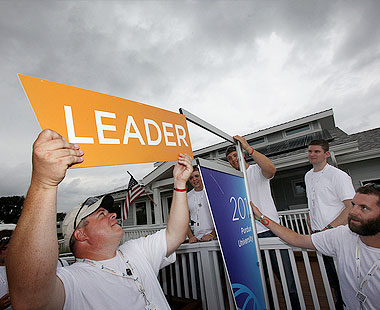Last Friday was a tough day for fans of sun-sourced electrical power. On Capitol Hill, Republican lawmakers were beating up on two executives from Solyndra, the defunct California solar panel manufacturer whose bankruptcy is proving to be such a headache for the Obama administration. Meanwhile, a mile or so away, the Department of Energy’s Solar Decathlon, a biennial eco-jamboree for renewable energy technology, opened to the public under murky skies and clammy sheets of rain.
Where’s your sun now?
This is the fifth Solar Decathlon, a 10-day event featuring 20 teams of college students who have designed and built solar-powered homes. It’s an educational and promotional endeavor, designed both to stoke public interest in solar technology (which, despite recent growth, still accounts for less than 1 percent of U.S electricity production) and prepare American kids for their future jobs laboring in the great clean-energy factories. Previous decathlons were held on the National Mall, where crowds could marvel at the “solar village” of gee-whiz houses temporarily installed in the shadow of the U.S. Capitol.
That bit of awkward political symbolism was missing this year: The competition was shunted off to West Potomac Park, over a mile from the nearest Metro station and safely out of sight of Republican congresspeople. Amid the crappy weather on opening day, only few intrepid visitors wandered around in the gloom as student-competitors mopped their houses (note to future designers: gutters!) and the arrays above struggled to gather stray photons.
But the sun returned, as it so often does, and on Monday came busloads of D.C. schoolchildren and sundry solar aficionados, many grizzled enough to date to the Carter-era solar boom.
For green-home geeks, the Solar D. is a dream date: a carbon-neutral compound of cool little eco-cabanas bristling with induction cooktops, bioremediation systems, and all manner of nifty energy-saving technology. Considering the logistical challenges — the homes are built off-site and trucked to D.C. in pieces to be reassembled in a public park — these are remarkably finished-looking structures. Most are variations on the Ikea-minimalist school of industrial chic, with more stainless steel and horizontal wood slats than a warehouse full of Dwell back issues. But a few oddballs stand out: CalTech’s CHIP is wrapped in tufted vinyl “outsulation” and looks like an upholstered shuttlecraft; the engagingly Canadian TRTL, from the University of Calgary, boasts a tipi-inspired domed roof.
The competition itself is part technology shakedown, part reality show. In addition to testing the homes’ architectural and engineering fundamentals, organizers put teams through their paces by making them host dinner parties and movie nights for rival competitors. When I strolled the grounds on Monday, the University of Maryland’s handsome WaterShed, which is surrounded by a constructed wetland of grey-water-filtering foliage, sat atop the leaderboard. Maryland is a previous decathlon contender, narrowly missing first place in 2007, and the team was gunning for a win this time after hitting high scores in the hot water and home entertainment contests.
But the People’s Choice Award votes were going to the joint across the street, Appalachian State’s Solar Homestead, a rambling collection of boxes with a great big shady porch, an outdoor kitchen, and a tiny in-law apartment. Maybe it was their eager outreach (team members were handing out mirrorized folding hats) or their underdog spirit (Appalachian State University doesn’t even have an architecture department), but these guys were charmers, and their house was so cool I wanted to load it onto a flatbed and drop it in my back yard.
Such real-world usability is a new emphasis this year: For the first time, the decathlon added an affordability contest. Teams that manage to build houses for $250,000 or less get maximum points, with deductions for more expensive homes. That tweak seems to have weeded out some of the more impractical creations. In 2009, a German team triumphed by entering a two-story cube swathed entirely in solar panels. The DOE says that this year’s entrants are about a third cheaper than previous homes, and several hew to the “passive house” model — hyper-insulated structures with minimal energy needs for heating and cooling, so their PV panels are smaller (and cheaper).
One of these budget eco-bungalows will actually serve as a home after the competition ends. The Empowerhouse, from Parsons the New School for Design and Stevens Institute of Technology, was developed in partnership with Habitat for Humanity and will be shipped to a low-income neighborhood in D.C., where a family will move in. It shared first prize in the affordability race, with a price tag of only $230,000.
On my way out, I joined some orange-clad young Tennesseans offering tours of the University of Tennessee’s Living Light, a cool little house with an iPad-controlled kitchen and self-draining bathroom. But it was the home’s solar panels that caught my eye: They were from Solyndra. UT’s house is the only one at the decathlon to adopt the innovative American-made design, which uses a network of cylindrical tubes that collect light from every angle, not just when the sun in directly overhead. (Perhaps not unrelated fact: Living Light’s $470,000 budget left it dead last in the affordability derby.)
UT junior Patrick Tormeno alluded only briefly to the Solyndra situation as he showed off the array overhead. “It’s kind of a bummer,” he said. “But it’s a really great product.”


